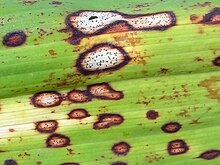| Phyllosticta | |
|---|---|
 | |
| Phyllosticta cruenta on Polygonatum odoratum found in Ryczów, Silesian Voivodeship, Poland | |
| Scientific classification | |
| Domain: | Eukaryota |
| Kingdom: | Fungi |
| Division: | Ascomycota |
| Class: | Dothideomycetes |
| Order: | Botryosphaeriales |
| Family: | Botryosphaeriaceae |
| Genus: | Phyllosticta Pers. |
| Species [1] | |
See text | |
Phyllosticta is a genus of fungi. Many of the species in this genus are common and important plant pathogens. They typically infect the foliage and cause tannish-gray leaf spots with dark brown to purple borders. However, Phyllosticta may also infect fruit and stems. Yield loss is a common consequence of Phyllosticta infection. [2] Representatives of the genus are found worldwide and on a wide range of plant hosts. [3]





